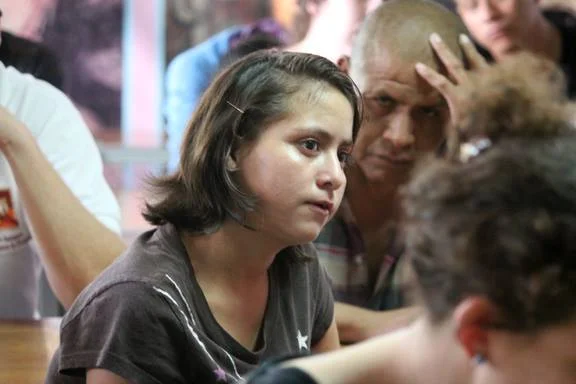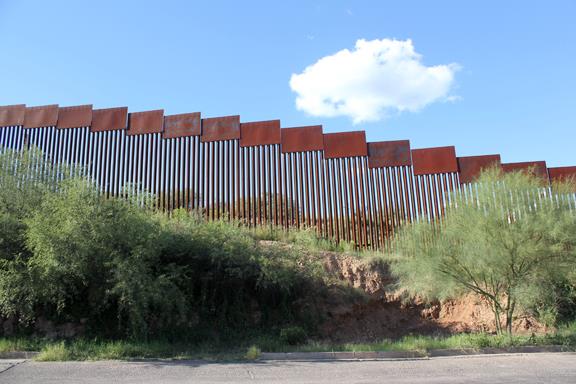Reporting by USDAC Storyteller-in-Chief, Lauren Zanedis
President Obama, in an announcement to the American public, reported that he would delay executive immigration action until after the midterm elections in November.
For many of us, like those in Congress, like President Obama, two months will pass in a hurried rush from late summer to fall, virtually unnoticed. Yet for those waiting at the border to begin their new lives, two more months is interminable.
For New York-based artist Janet Goldner, the decision to postpone any action on the issue was simply unacceptable. Goldner decided to make a cross-country trip to Arizona, though her impulse wasn't solely politically driven: "My intent was to understand border issues from a human, intimate, firsthand point of view...The reports of the unaccompanied child migrants spurred my trip but I went not thinking yet about solutions. I wanted to understand for myself." She recounts that it is often difficult, perhaps impossible, to get a realistic understanding of what is happening at the border unless you're there. If you're not observing for yourself, she says, "it is easy for Americans to dismiss 'those people' and their problems."
Goldner got in touch with USDAC Cultural Agent Michael Schwartz and Tucson Field Office Deputy Agent of Details Sandra Bernal, flew from New York to Tucson, Arizona on Saturday, September 13, and planned an excursion to the border to obtain a vivid, on-the-ground understanding of the crisis.
The next day, Goldner, Schwartz, Bernal, and their team visited the Kino Border Initiative’s kitchen (KBI), a binational organization located in Nogales, Sonora, Mexico. Run by Jesuit priests, its vision is to facilitate a humane, just, and workable migration between the U.S. and Mexico. Migrants often arrive to the KBI with nothing more than the clothes they are wearing and a small bag of items they’ve taken from home. At this pivotal moment in their lives, Goldner described some of the migrants as looking "incredibly haunted," presumably by their past journey, their present circumstances, and their undefined future.



KBI provides people who have just been deported and people who are about to cross the border with food, some clothing and sometimes first aid. Our USDAC team was particularly interested in the role of the arts during this difficult moment in the lives of the 78,000 migrants currently displaced. Can cultural diplomacy act as a lever to help support those who have left their home and who are eagerly in search of another? How might the arts offer a means of expression to the migrants themselves? Could professional artists add context or a depth of analysis to the crisis?
With a fence that cost American taxpayers $40 billion to build the "imaginary line in the sand is reinforced by metal, laws and military," says USDAC Cultural Agent Michael Schwartz. As the border between Mexico and the United States becomes fraught with incredible tension, an insurgency of border artists, as it were, have cropped up, greeting those that make this hallowed journey with colorful murals, photographs, and resonant messages. (Agent Schwartz notes, "there is an ongoing conversation in many circles about what it means to be a migrant, [to have a particular] identity and [to] assimilate.") Known as “border art,” these works prompt compelling questions: what does it mean when art, when people, are not necessarily rooted to a place, but instead are mobile and ever changing? Such border art speaks exactly to this moment of transience in which each and every one of these migrants reside. But, it also speaks to the very real and tangible fence that serves as an immediate impediment to their journey. "The militarization of the border is clear," Goldner notes. It also acts as the first, very immediate, sign of the difficulty that the migrants will have to face on the 'other side.'


This is where Jon McLane, USDAC Tucson Field Office Deputy Press Agent and founder of SAFE Park, comes in. McLane founded SAFE Park as a place for those displaced, migrants, refugees and people down on their luck to have a place to sleep and store their belongings 24 hours a day without fear of arrest or harassment by local authorities. While providing for their basic needs, SAFE Park also provides provisional housing, a model they’ve landed on after two years of in-field study and testing the limitations on safe places to sleep and exist in downtown Tucson. McLane and those at SAFE Park are not only giving these homeless—with many migrants among them—a place to sleep, but also a place to store their IDs, their clothes, and anything else, however small, they’ve taken with them on their journeys.
Many of us, myself included, fall into thinking that as long as basic necessities are met, we’ve done our duty. This line of thinking is faulty, though. What is also integral—and it is a service that SAFE Park provides—is the ability to have a place to call home, to leave for the day and to come back, to know that your things, however many or few, are still there when you return.
But, it is also our duty to provide the infrastructure to encourage cultural sharing and belonging.
I asked of those who went on the excursion how migrants could possibly focus on art, on engaging in any cultural diplomacy at a time when their basic needs were barely being met. Those with whom I was speaking clamored to tell me just how wrong this assumption was, that each person doesn’t leave their culture behind when they move, when they emigrate from their home country, when they visit the U.S/Mexican border for a week to determine the work there is to be done, but that, instead, it is a sworn part of themselves. In a way, there are no borders when it comes to culture; what you say, how you say it, the songs you sing, the recipes you default to when you’re making a meal for your family, these are the pieces of culture that are so integral for each one of us, whether or not we've crossed national borders. In theory, there is no losing that part of ourselves, but we must create the conditions to welcome it.
Goldner describes the week as a "wildly successful collaboration which I hope will continue to grow." She says it will take some time for the photographs, video, and writing from the week to coalesce into action. Cultural Agent Schwartz suggests that given sufficient time and reflection, "artists help provide context and deepen this discussion; [they] provide platforms and challenge assumptions about this issue." Migration is natural, he added. "People, plants, and animals continue to migrate back and forth, as they have since forever."
All photo credit: Janet Goldner


